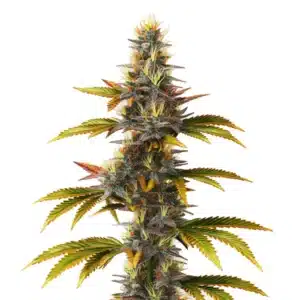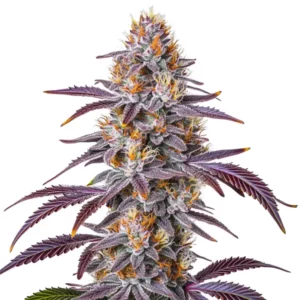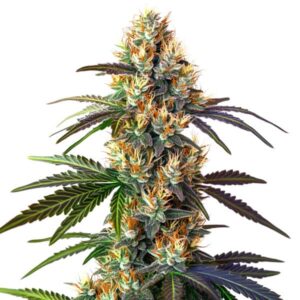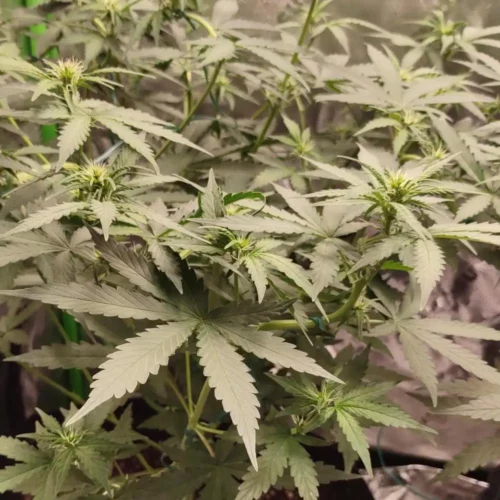Low Stress Training Weed (LST) represents a pivotal technique in the cultivation of cannabis, aimed at optimizing plant growth and increasing yields without causing significant stress to the plants. This method involves gently bending and tying down the branches of weed plants, encouraging them to grow horizontally rather than vertically. By manipulating the plant structure in such a way, LST makes it possible to expose more of the plant to light, leading to a more even canopy and, ultimately, a higher yield. This article delves into the nuances of low stress training weed plants, offering insights into its benefits, implementation, and best practices to maximize your cannabis cultivation efforts.
The Fundamentals of Plant Stress Response
Plants, including cannabis, have evolved mechanisms to respond to various environmental stresses, both abiotic (non-living) and biotic (living). When a plant experiences stress, it triggers a physiological response that can alter its growth pattern. Autoflower low stress training manipulates this response in a controlled manner to benefit the plant. By gently bending and securing the branches away from the central stem, autoflower low stress training simulates a mild form of stress that encourages the plant to redistribute its energy and growth hormones, such as auxins, towards new growth sites.
Phototropism in Low Stress Training weed
Phototropism, the growth of a plant in response to light, plays a crucial role in the effectiveness of LST. Cannabis plants naturally grow towards the light source, prioritizing the development of the main stem or cola. Low Stress Training weed techniques manipulate this natural tendency by adjusting the plant’s orientation, ensuring that light reaches more areas of the plant evenly. This not only promotes the growth of multiple colas but also results in a fuller, bushier plant with increased bud sites.
Apical Dominance
Apical dominance is a growth pattern in plants where the main central stem grows more vigorously than the side branches, primarily due to the concentration of growth hormones at the tip of the plant. Low Stress Training weed plants disrupts apical dominance by bending the main stem, which encourages the side branches to grow more vigorously. This disruption leads to a more horizontally spread plant with numerous dominant colas, rather than a single vertical main stem. The redistribution of growth hormones, particularly auxins, plays a crucial role in breaking apical dominance and encouraging more uniform growth.
By gently bending the main stem away from its vertical growth, this technique breaks the natural suppression of lateral branches. This adjustment allows lower growth points to flourish, leading to a more evenly distributed canopy. As a result, energy shifts toward developing multiple productive bud sites.
Auxins in LST
Auxins are a class of plant hormones that play a key role in the regulation of plant growth and behavior, including cell elongation, bud growth, and root development. When a cannabis plant undergoes LST, the redistribution of auxins from the main stem to the lower branches stimulates these branches to grow more vigorously. This hormone redistribution mimics the natural response to environmental stress, leading to an increase in the plant’s overall growth rate and a more efficient use of available light.
Stress Recovery and Growth
An essential aspect of LST is the plant’s ability to recover from the stress induced by training. This recovery process is where the plant strengthens the areas that were bent and secured, leading to thicker stems and branches that are better able to support the weight of larger buds. Additionally, the mild stress induced by LST can trigger a secondary metabolite response in the plant, potentially leading to an increase in the production of cannabinoids and terpenes, enhancing the quality and potency of the final product.
Optimizing LST for Maximum Yield
The science behind low stress training weed plants emphasizes a balanced approach to stress management. By learning how the plant responds to light and hormone distribution, growers can adjust growth patterns to enhance both yield and potency. The key to successful Low Stress Training Weed lies in careful, gradual adjustments that encourage the plant to develop a wide, even canopy, ensuring that each branch receives ample light and has the space to develop fully.
Enhanced Light Distribution
One of the primary benefits of low stress training for cannabis cultivation is the improved light distribution it offers. Low Stress Training Weed Plants techniques allow growers to manipulate the structure of their cannabis plants, spreading out the branches and creating a flatter canopy. This adjustment ensures that light reaches more parts of the plant equally, facilitating a more uniform and efficient photosynthesis process. The result is a plant that can produce more energy for growth and flowering, leading to increased yields.
Reshaping the plant through low stress training allows light to reach all areas of the canopy. This even illumination supports efficient photosynthesis and healthier leaf development. With each branch receiving ample sunlight, the plant experiences balanced growth, resulting in improved vigor and overall performance.
Increased Yield
The benefits of low stress training for cannabis cultivation become particularly evident when evaluating crop yield. By optimizing the exposure of all parts of the plant to adequate light, LST encourages the development of multiple bud sites. This not only maximizes the productive capacity of each plant but also leads to a more substantial overall harvest. Growers utilizing LST can expect a noticeable increase in yield compared to traditional growing methods where the central cola dominates, and lower branches may produce smaller, less potent buds.
When the plant’s structure is optimized through low stress training, it fosters the growth of numerous bud sites rather than concentrating on a single main stem. This leads to better light exposure and nutrient allocation, ultimately boosting the harvest potential and enhancing the overall productivity of the crop.
Improved Air Circulation and Reduced Disease Risk
Another significant benefit of low stress training for cannabis cultivation is the promotion of better air circulation around and within the plant structure. LST’s method of spreading out the branches and opening up the plant’s canopy allows for air to move more freely. This improved airflow helps to reduce the humidity levels within the canopy, a critical factor in mitigating the risk of mold and fungal diseases. Healthy air circulation ensures that the microclimate around the plants remains optimal, further contributing to the plants’ overall health and resilience against pests and diseases.
Efficient Use of Growing Space
For cultivators working with limited space, the benefits of low stress training for cannabis cultivation extend to the efficient use of available growing areas. Low Stress Training Weed enables growers to direct the growth of their plants horizontally, making it possible to fit more plants into a smaller space without sacrificing their access to light or air. This technique is particularly beneficial in indoor growing setups where space is at a premium. By maximizing the canopy’s spread within the available area, growers can achieve higher productivity per square foot.
Stress Reduction and Plant Health
While it may seem counterintuitive, one of the benefits of low stress training for cannabis cultivation is the reduction of stress on the plants. Low Stress Training Weed plants involves gentle bending and securing of branches, which, when done correctly, does not cause significant harm or stress to the plant. This gentle approach to manipulating plant growth contrasts with high-stress training methods that involve cutting or breaking parts of the plant. By avoiding these harsher techniques, LST promotes a healthier growth process, leading to stronger, more robust plants.

How to Implement Low Stress Training on Weed Plants
Low stress training (LST) on weed plants is a pivotal technique for optimizing the growth structure and maximizing the yield of cannabis. By employing LST, growers can manipulate the plant’s shape to expose more of its surface area to light, leading to increased bud production. Here’s a more detailed exploration of how to implement low stress training on weed plants, emphasizing the importance of timing, technique, and ongoing care.
Begin by preparing the necessary tools and materials for gentle manipulation. Carefully bend and secure branches to encourage horizontal growth, then monitor the plant’s reaction. Regular adjustments ensure the canopy remains evenly spread, supporting efficient light distribution and reducing stress, which promotes a robust, high-yielding plant.
Preparing for Low Stress Training Weed Plants
The first step in implementing low stress training on weed plants involves preparation. Gather the necessary materials, including soft ties, plant wire, or string, and stakes or hooks for securing branches. Selecting the right materials is crucial to avoid damaging the plant. Soft, flexible ties are recommended to gently guide the plant’s growth without cutting into the stems.
Timing for Low Stress Training Weed
Timing is critical when implementing training on weed plants. Learn when to start low stress training and when to start lst—the ideal period is when the plant has developed three to four nodes, usually a few weeks into the vegetative stage. This timing ensures that the plant is young enough to be pliable and resilient to manipulation but established enough to handle the stress of training.
Step-by-Step Process for Low Stress Training Weed Plants
- Gentle Bending: Carefully bend the main stem of the weed plant away from the vertical and secure it to the side of the pot or the ground. The objective is to encourage horizontal growth and allow light to reach lower branches.
- Securing Branches: Use the soft ties to gently pull down and secure the side branches to the pot’s edge or stakes in the soil. The aim is to create a flat, even canopy that maximizes light exposure to all parts of the plant.
- Adjustment and Maintenance: As the weed plant grows, regularly adjust the ties to guide its shape and ensure even light distribution. It’s important to monitor the plant’s response to low stress training and make adjustments as needed to avoid over-stressing the plant.
Monitoring Growth During Low Stress Training Weed Plants
Continuous observation is key when implementing training on weed plants. Consider reviewing the plant’s performance before and after low stress training to ensure optimal growth, such as wilting or discoloration, and adjust the training regimen accordingly. Healthy weed plants will quickly adapt to their new shape, showing vigorous growth and increased branching.
Combining Low Stress Training with Other Techniques
For optimal results, low stress training weed plants can be combined with other cultivation techniques, such as topping or pruning, to further control growth and increase yields. However, it’s essential to balance these practices carefully to avoid over-stressing the weed plants.
Tips for Successful Low Stress Training Weed Plants
- Be Patient: Low stress training is a gradual process. Allow time for the weed plants to adjust and respond to the training.
- Be Gentle: Avoid applying too much force when bending branches to prevent damage.
- Regular Adjustments: As weed plants grow, continually reassess and adjust the ties and branches to maintain the desired shape and maximize light exposure.
Combining LST with Other Training Techniques
Low stress training can be effectively combined with other plant training techniques for even greater yields. Techniques such as topping or fimming, when used in conjunction with LST, can encourage the plant to become bushier and more robust.
- Topping: This involves cutting the top off the main stem, encouraging the plant to grow two main colas instead of one. When combined with LST, topping can significantly increase the number of top colas, leading to a more substantial yield.
- Fimming: Similar to topping but less precise, fimming encourages the plant to produce four main colas at the cut site. When applied with LST, fimming can create a highly bushy plant with numerous bud sites.
Expert Tips for Maximizing LST Benefits
- Start with a Plan: Visualize the desired shape and structure of your plant before beginning Low stress training weed plants. This foresight helps in making strategic decisions about which branches to bend and where to secure them.
- Regular Observation: The key to successful LST is regular observation and adjustment. As the plant grows, new tying points may be needed, and previously placed ties may need to be loosened or moved.
- Stress Recovery: Allow your plants time to recover from stress. After adjusting ties or combining LST with other techniques, give the plant a few days to adapt before making further changes.
- Soil Health: A healthy root system supports vigorous growth above ground. Ensure your soil is well-aerated and rich in nutrients to support the increased demands of LST-treated plants.
Promos & Deals
Low Stress Training Autoflowers
Autoflowering cannabis strains including examples like lst autoflowers and autoflower lst, have become increasingly popular due to their short life cycle and ease of cultivation. These plants automatically switch from the vegetative to the flowering stage without the need for a change in light cycles. While this makes autoflowers convenient and easy to grow, it also means that growers have a shorter window of time to apply LST effectively.
Autoflower Characteristics
Before applying Low Stress Training Weed to autoflowers, it’s crucial to understand their growth characteristics:
- Rapid Growth Cycle: Autoflowers typically complete their lifecycle in 8-10 weeks, leaving a narrow window for training.
- Resilience: Autoflowers are generally robust and can recover from stress quickly, making them suitable candidates for Low stress training weed plants.
- Size: Autoflowers are usually smaller than photoperiod strains, which influences how much they can be trained without overburdening the plant.
Timing is Everything
The key to successful LST on autoflowers lies in timing. Since autoflowers have a predetermined lifecycle, starting LST too late can be ineffective, while starting too early might stress the plant unnecessarily. The ideal time to begin LST on autoflowers is once they have developed 4-6 true leaves, typically in the second or third week of growth.
LST Steps for Autoflowers
- Gentle Bending: Start by gently bending the main stem and securing it with soft ties, aiming to create a wider, more open plant structure. This should be done gradually over several days to avoid stressing the plant.
- Monitor Growth: Autoflowers grow quickly, so it’s essential to adjust ties and redirect growth regularly to maintain an even canopy.
- Avoid High-Stress Techniques: Techniques that cause significant stress, like topping or fimming, are generally not recommended for autoflowers due to their short vegetative phase.
Best Practices for Low Stress Training Autoflowers
Applying LST to autoflowers requires a careful approach to ensure the plants can benefit from the training without hindering their growth.
- Start Early but Not Too Early: Allow the plant to develop a strong stem and several sets of leaves before beginning Low stress training weed plants. This ensures the plant is robust enough to handle manipulation.
- Be Gentle: Autoflowers are resilient but still susceptible to stress. Make adjustments gradually and carefully to avoid damaging the plant.
- Optimize Environmental Conditions: Since autoflowers have a short growth cycle, providing optimal conditions (light, nutrients, water, and airflow) from the start is crucial to maximize the benefits of LST.
- Continuous Adjustment: Given the rapid growth of autoflowers, regular monitoring and adjusting of ties are necessary to ensure the plant develops a balanced canopy.
Troubleshooting LST on Autoflowers
While LST is generally beneficial, there are potential challenges specific to autoflowers:
- Stunted Growth: If an autoflower appears stunted after LST, it may be experiencing too much stress. Ensure the plant has optimal growing conditions and consider easing the intensity of training.
- Overcrowding: Due to their compact size, autoflowers can quickly become overcrowded when using Low stress training weed plants. Pruning lower, non-productive branches can help improve airflow and light penetration to the lower buds.
Enhancing Autoflower Yields with LST
Low stress training autoflowers provides growers with an excellent chance to maximize yield despite the fast growth cycle. By recognizing the specific needs of autoflowers and applying LST principles carefully, cultivators can greatly enhance their harvest. Success depends on gentle and timely interventions that promote a more productive canopy without overwhelming these resilient plants.
Incorporating LST into the cultivation of autoflowers involves knowing both the technique and the unique growth patterns of autoflowering cannabis. When applied properly, LST can result in impressive yields in autoflower crops, making it a valuable tool for growers.
Low stress training weed plants is a powerful technique that, when mastered, can significantly enhance the yield and quality of your cannabis crop. By mastering the nuances of LST and combining it with other training techniques, growers can achieve a highly efficient, productive grow operation. Keep in mind, success with Low stress training weed plants depends on patience, careful observation, and ongoing learning. With these principles in mind, both novice and experienced cultivators can harness the full potential of low stress training weed plants to produce exceptional cannabis that stands out for its quality and quantity.

FAQs about Low Stress Training
What is minimal stress training cannabis?
Minimal Stress Training Cannabis involves gently bending and securing branches to encourage horizontal growth and maximize light exposure. This technique reduces plant stress, increases canopy evenness, and promotes a higher yield while preserving overall health and resilience during the entire life cycle in outdoor conditions.
When should I begin low stress training on my cannabis plants?
Initiate low stress training when cannabis plants develop three to four nodes during early vegetative stage. This timing ensures sufficient stem strength and flexibility for gentle bending. Early intervention enables better light distribution, encourages horizontal growth, and leads to productive canopies for enhanced yield performance.
How do secondary keywords improve content SEO?
Integrating secondary keywords like lst autoflowers and when to start lst enriches content relevance, supports natural language patterns, and diversifies search queries. They complement primary terms by targeting additional user intents, ultimately increasing visibility, improving rankings, and attracting a broader audience in competitive cannabis niches.
















